
Cornerstone Theatre Company and the city of West Hollywood celebrate their mutual Silver Anniversaries with the World Premiere of Making Paradise: The West Hollywood Musical. Featuring a cast of thirty-one, some of whom have never acted before, let alone sung and danced on a theater stage, Making Paradise tells the story of the founding of WeHo through exactly the kind of people who make up its population—a gay, lesbian, straight, and transgender, rainbow colored, multiracial, multiethnic mix of 20somethings, middle-agers, and octogenarians. Some of the voices are only so-so and some cast members appear to be working hard on remembering which dance step follows which—and it matters not a whit. Making Paradise: The West Hollywood Musical succeeds not just because of its strengths but also because of (what in a more traditional production would be considered) its weaknesses. It’s a thrilling, dramatic, informative, entertaining, suspenseful, and ultimately quite moving piece of theater.
Book writer Tom Jacobson tells a more straightforward story than is usual for the current Ovation Award nominee, one based on interviews conducted with more than fifty West Hollywood residents. Besides the obligatory history lesson, Jacobson’s book features several compelling plot threads and some surprising twists and turns, including a mystery with an unexpected eleventh-hour resolution. There are love stories, of both same and opposite sex variety, a good deal of social commentary, and even a bit of criticism of today’s WeHo.
We begin in the present, in the West Hollywood coffee shop where it all started a quarter century ago. Desiree (Gillian Doyle), a WeHo city worker, and Henri (Bahni Turpin), a linguist at SUNY Albany, have reunited for the first time in years, Desiree still bitter about Henri’s move back east, Henri critical of what she sees as Desiree’s abandonment of the principles that united them decades before in their fight for a city they could call their own.
Before you can say musical flashback, the scene has shifted to the ‘80s for the show’s rousing opening number, “1984,” featuring virtually the entire cast in 1980s hair and other assorted period regalia, singing and dancing and wondering about the year to come: “What’s around the bend? How can we find salvation? Revolution is the word!”
The story then resumes at the very same WeHo coffee shop, but circa 1983, straight gal Desiree and lesbian Henri (now played by Chris Farah and Diana Mera) sharing a booth with their gay pals Curly (Derek Manson), a law student from Oklahoma, and Jesus (Richard Rocha), a UCLA post-grad working on his Masters in Social Work. The quartet’s talk is, not surprisingly, of a political nature, Henri and Jesus expressing through song their dream of “a refuge for the strange, the freaks with flag unfurled, a place to call our own in this standoffish world.”
As the foursome move ahead with their plan to form the first ever Gay City, their lives intersect with others who share their dreams, as well as some who do not. Desiree becomes romantically involved with a Russian photographer named Yuri (Peter Howard); Curly’s male libido finds itself stimulated by Harold (Peter James Smith), a married Episcopal priest on the downlow, Maria (Desiree Jade Sol), a transgendered Latina, Todd (Ronn Jones), an anti-rent control property owner with a double life in B&D, and the adorable Jesus (though not necessarily in that order).
At town meetings, cityhood is debated. Should renters’ rights take precedence over all others? If West Hollywood is to be the country’s first “gay city,” then what about its Russian population and its seniors? Property owners connive to maintain power. Immigrants, gays, seniors, and others express mutual distrust bordering on downright hatred, which they sing about in “E. Pluribus Chaos”: “The homos hate the heteros, the zealots light the fuse, the seniors hate the youngsters, and the youngsters hate the rich.” With so many disparate factions, is there any likelihood whatsoever that West Hollywood can assert its independence as a city?
Then comes October 31, 1983, a night that has the entire cast donning outrageously imaginative Halloween costumes for the Act One finale, “Disguised As Myself.” Not all is celebratory joy however, for lurking among the revelers are Russian thugs bent on defeating West Hollywood gay cityhood by whatever means possible. Revelry turns tragic as Act One ends with the squeal of burning rubber, one major character dead, and plenty more music, romance, and drama yet to come.
Making Paradise does bite off a lot plotwise, perhaps a tad more than it can chew, but like its cast’s varying levels of theatrical experience and musical talents, it hardly matters. Making Paradise’s heart is in the right place, and a big, bold heart that is.
Making Paradise’s songs (music by Deborah Wicks La Puma and lyrics by Shishir Kurup, won’t likely make it on or off-Broadway, but they do the trick here. Standouts include a pair of rousing anthems (“1984” and “Paradise”), a cleverly-lyricked love song (“Generic Love Song”), and a powerful declaration of self-worth (“Who I Am”), sung at various intervals by Maria, Harold, and Curly.
There are numerous standouts in Making Paradise’s huge cast, most notably charismatic triple-threat Manson as the drug-&-sex-addicted Curly and newcomer Rocha doing deeply moving work as Jesus. The duo are the production’s strongest vocal talents as well.
Smith, one of L.A. finest working actors, turns out to be a tiptop song-and-dance man as well. Jones is a commanding presence as both businessman and S&M master. Doyle and Turpin do gutsy work as the 2009 witnesses to what is happening onstage below them. Colorful performances are delivered by Farah, Lori Kaye (as lesbian activist Rose), and Steve Keyes (as prophet and/or nutcase Don). Real-life transgender community activist Sol does some of the evening’s gutsiest work as Maria, née Ramon. Cornerstone founding member Howard is excellent—and amazingly believable—as Russian-speaker Yuri. In a confusing bit of miscasting, however, African American “older” Henri turns Latina as “younger” Henri in the 1980s, and though the heavily-accented Mera gives the part her all, Henri’s ethnicity switch makes no sense.
The rest of the huge ensemble is made up of past, current, and/or possibly future West Hollywodians, from a recent Cal State Northridge grad who only this year experienced his first LA Gay Pride to the organizer of the WeHo’s first Russian LGBT organization to legendary lesbian activist Ivy Bottini, 84 years of age and still going strong. In addition to Bottini, the chorus is completed by Solé Arevalo (Comby), Timothy Eric Dixon, Frances Dorantes, transgender activist Jake Finney (Bobby, Henrik), Rachel Garcia, Dena Gorilik (Bielke), Elaine Johnston (Mabel), Jeanne F. King (Daisy), Michael Korhonen (Sid, 2009 Joey), Dimitriy Kostins (Sasha), Barbara Krupa (Lola), Marcos Nájera, Miguel Ortiz (Bobby understudy), Alison Regan (Sally), Brian Rodda (1980s Joey), Greg Harlan Roth (2009 Curly), Larry Rubenstein (Nahum), and Chester G. Sakamoto.
Directors Michael John Garcés and Mark Valdez deserve high marks for helming what has surely been a monumental undertaking. Choreographer Shetal Gandhi and musical director Kyle de Tarnowsky have worked wonders with Making Paradise’s “multi-level” cast, backed by a sensational five piece band: de Tarnowsky on keyboards, Matt Lemcke on bass, David Olivas on keyboard and saxophone, Perry Senn on drums, and Alex Williamson on Guitar.
Staging Making Paradise in West Hollywood’s Plummer Park’s Fiesta Hall, one of the musical’s actual settings, was a stroke of genius, a crackerjack design team collaborating to make the community meeting hall work as well as imaginable. Shigeru Yaji’s scenic design consists mainly of movable coffee shop booths, with audience members seated on folding chairs house left and house right—but it works perfectly. Meghan E. Healey’s costumes go from nostalgic ‘80s wear to a few dozen highly imaginative Halloween costumes. (Manson’s hoop-skirted nun’s habit is a standout, and Manson looks gender-bendingly fetching in it.) Tom Ontiveros’s lighting adeptly reinforces the musical’s shifting moods. Alyssa Ishii’s sound design does a very good job of mixing amplified voices and musical accompaniment. Nikki Hyde is stage manager and Stuart & Susan Berton are executive producers.
In the end, Making Paradise: The West Hollywood Musical succeeds as much because of its cast’s varying degrees of talent and experience as despite them. Stirring, entertaining, educational, and uplifting, Making Paradise is truly in a class all by itself.
Fiesta Hall in Plummer Park, 7377 Santa Monica Blvd., West Hollywood.
www.CornerstoneTheater.org
–Steven Stanley
October 24, 2010
Photos: John C. Luker

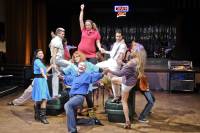
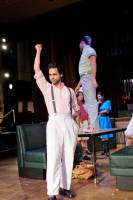
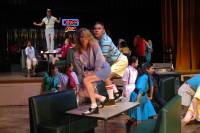
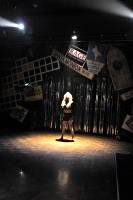
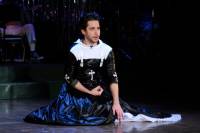
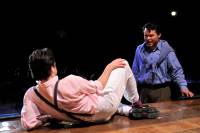
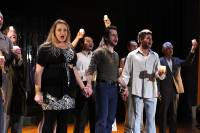
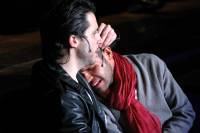

 Since 2007, Steven Stanley's StageSceneLA.com has spotlighted the best in Southern California theater via reviews, interviews, and its annual StageSceneLA Scenies.
Since 2007, Steven Stanley's StageSceneLA.com has spotlighted the best in Southern California theater via reviews, interviews, and its annual StageSceneLA Scenies.







 COPYRIGHT 2024 STEVEN STANLEY :: DESIGN BY
COPYRIGHT 2024 STEVEN STANLEY :: DESIGN BY